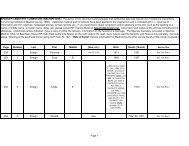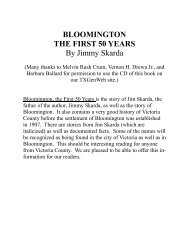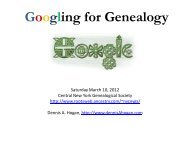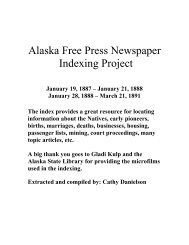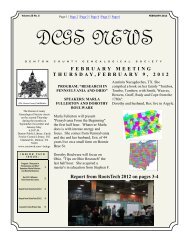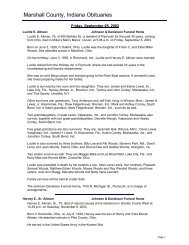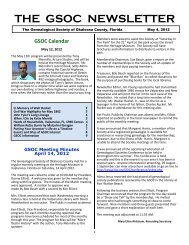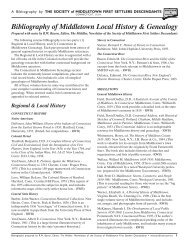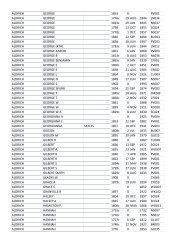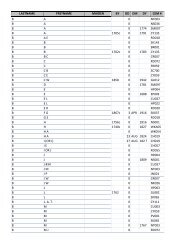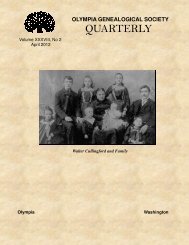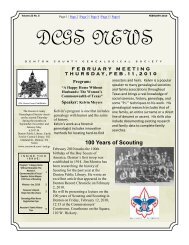June 1996 Newsletter [v5.0] - RootsWeb
June 1996 Newsletter [v5.0] - RootsWeb
June 1996 Newsletter [v5.0] - RootsWeb
You also want an ePaper? Increase the reach of your titles
YUMPU automatically turns print PDFs into web optimized ePapers that Google loves.
German-Bohemian<br />
Heritage Society<br />
<strong>Newsletter</strong><br />
the<br />
Heimatbrief<br />
P.O. Box 822<br />
New Ulm, Minnesota, 56073-0822<br />
Email: Society & <strong>Newsletter</strong>: lalgbhs@newulmtel.net<br />
Research Info: rpaulgb@winternet.com<br />
Vol VII No. 2 <strong>June</strong> <strong>1996</strong> Louis Lindmeyer, Editor<br />
A Letter From Our President<br />
Dear Members:<br />
In November of '95 I received a letter from<br />
Professor LaVern Rippley stating that he thought<br />
it would be in the best interest of the GBHS if he<br />
resigned from his position on the board.<br />
Professor Rippley is the head of the German<br />
Department at St. Olaf College in Northfield,<br />
MN. This keeps him very busy and often these<br />
duties created a problem when it came time to<br />
attend our board meetings.<br />
I received his letter shortly after our November<br />
meeting and the board was not scheduled to meet<br />
again until February of '96. I chose not to write<br />
about this until I knew how everything was going<br />
to unfold.<br />
The board of directors accepted Professor<br />
Rippley's resignation and on the February 24th<br />
meeting we went about the business of replacing<br />
him. Following a good discussion a vote was taken<br />
and Don Zwach was chosen as that person. After<br />
the meeting I contacted Mr. Zwach and made him<br />
aware of the decision, which he gladly accepted.<br />
Don will be serving the remainder of Vern's term<br />
which expires at the end of this year. He lives in<br />
Waseca, MN and will be retiring from teaching at<br />
the end of this school year. He was present at our<br />
March 16th meeting and I was very impressed<br />
with his debut. Don has a lot of energy and<br />
1<br />
brought forth some new and good ideas.<br />
Although Professor Rippley is no longer a voting<br />
member of our board, we have not completely<br />
parted company. Vern is willing to serve in an "oncall"<br />
basis by which he would still be able to<br />
contribute when needed. I am very happy with<br />
this arrangement because I want to stay in touch<br />
with him. He was one of the people instrumental<br />
in getting this organization started. We needed<br />
his help in telling our ancestors story, as this story<br />
had not been told before. He so eloquently did this<br />
as evidenced by his book entitled "German-<br />
Bohemian - the Quiet Immigrants. "<br />
Because of Vern's many contributions the board<br />
decided to make him a board member emeritus,<br />
with a lifetime membership. This is an honorary<br />
title and is our way of thanking him for all he has<br />
done.<br />
I am glad these things worked out as they did and<br />
I hope you will agree that the outcome was<br />
favorable for everyone.<br />
Paul Kretsch, President<br />
<strong>Newsletter</strong> Deadline<br />
The next edition of this newsletter is scheduled<br />
for publication in September. If you wish to<br />
contribute an article, send us a query, or write us a<br />
letter, our deadline is August 1. Thank You!
Whats New<br />
As you have already seen we have made some<br />
changes to our newsletter. First we have changed<br />
the name to include “Heimatbrief” meaning<br />
homeland letter or letter from the homeland. One<br />
of the purposes of this newsletter is to educate our<br />
members about the homeland with interesting<br />
articles that give you a sense of what life was<br />
like “over there”. We hope that this newsletter<br />
is like a letter from the homeland whether you<br />
feel your homeland is New Ulm, Minnesota or<br />
Muttersdorf, Bohemia.<br />
The photograph in the upper left corner is the<br />
German-Bohemian Immigrant Monument erected<br />
in 1991 by the German-Bohemian Heritage<br />
Society. The bronze statue of a man, woman and<br />
child was sculpted by a German-Bohemian,<br />
Leopold Hafner of Germany. If you would like to<br />
“read more about it” order the German-Bohemian<br />
Immigrant Monument book in the “History For<br />
Sale” section of this newsletter.<br />
We have also changed our print to a more reader<br />
friendly style that will be easier on the eyes<br />
making the newsletter more enjoyable to read.<br />
Also, we have included more photographs and<br />
images to break up the text trying to follow the<br />
saying that “one picture is worth a thousand<br />
words”.<br />
It is said that change is good. We hope you agree.<br />
Write us and let us know. LAL<br />
Our Readers Write<br />
I received my March <strong>1996</strong> copy of the G.B.H.S.<br />
<strong>Newsletter</strong> and noticed portions of my last letter<br />
to you printed in the 'Our Readers Write' column.<br />
Also noticed the town in Bohemia that my<br />
grandparents, Andreas (Andrew) Ubl and<br />
Margaret (Foraschick) Ubl came from was spelled<br />
incorrectly. Since the correct spelling of family<br />
names and town names is so important, I am<br />
requesting a correction of the town name to be<br />
printed in the next <strong>Newsletter</strong>. The correct<br />
spelling is WOTTOWA.<br />
I would also like to comment on the article 'The<br />
Village of Wasserau and the Rubey Family'. The<br />
article was Wonderful! The part that interested<br />
me the most was the part about the end of the<br />
Second World War and the expulsion of all<br />
2<br />
German-speaking people from Bohemia.<br />
I have German-Bohemian great-grandparents<br />
who emigrated from Bohemia in 1882, leaving<br />
their village of Ulbersdorf (county of Komotau) to<br />
settle in Nebraska. Ulbersdorf is located north<br />
northwest of Prague. Hollmotz cousins who<br />
remained in Bohemia were among those forced<br />
from their homes and out of the country that had<br />
been home to their ancestors for generations.<br />
Leaving Bohemia with only the belongings they<br />
could carry and with the small amount of money<br />
they had, they traveled to Germany. At this<br />
point I do not know exactly what happened to<br />
them. They ended up in an 'immigrant camp' on<br />
the Isle of Usedom, which is located directly<br />
north of Berlin on the Baltic Sea. They were<br />
apparently held there for weeks and even months<br />
before they were allowed to relocate. The<br />
conditions were not good in the camp and several<br />
of my cousins died there. They had little money<br />
and were forced to sleep on beds of straw in barn<br />
like structures. They probably were barns! I don't<br />
know if they were held there by the Germans or<br />
by the Russians as that was part of the Russian<br />
Zone.<br />
After leaving the Isle of Usedom, the surviving<br />
cousins, Adolph and Theresia and their daughter<br />
Sophia settled in one town and their son Herbert<br />
settled in another. Sophia apparently worked<br />
and cared for her parents as they were not young.<br />
(Adolph died in 1978 at the age of 88)<br />
The saddest part of their relocation is that when<br />
the Berlin Wall went up, Adolph, Theresia and<br />
Sophia were on one side and Herbert was on the<br />
other. Herbert, being in East Germany, was not at<br />
first allowed to visit his parents. By the time he<br />
became a pensioner he and his wife were allowed<br />
to ' cross over' twice a year to visit his parents. By<br />
this time Herbert had a grown son and two<br />
grandsons that Adolph and Theresia had never<br />
seen. Sophia died in 1974, leaving Adolph and<br />
Theresia old and lonely with no family to care for<br />
and comfort them.<br />
My great-grandfather, Joseph Hollmotz<br />
corresponded with his cousin Adolph for many<br />
years. After his death his daughter (my great<br />
Aunt Maxine) continued the correspondence, and<br />
after her death in 1986, I found Adolph's address<br />
and I wrote to him only to find out he had died in<br />
1978. His wife Theresia and I wrote back and
forth for a few years. She helped me with the<br />
Family Tree as much as she could. She would<br />
write in German and I would find someone to<br />
translate it. She lived on a small pension and it<br />
was very expensive for her to have her letter<br />
translated to English before she sent it to me. I<br />
would purchase International Reply Coupons at<br />
my Post Office and send them to her. She would<br />
then use them to purchase stamps to mail her<br />
letters to me.<br />
When the Berlin Wall came down I was so happy<br />
to think that if Theresia was still alive she<br />
would finally be able to be with her son and his<br />
family. I have not heard from her since 1983 and<br />
of course have had no contact with Herbert.<br />
Kay Hall<br />
Glendora, CA<br />
...Also in your next newsletter could you ask if<br />
anyone knows of a dish called “Bützle und Dunk”<br />
( at least that is what it sounded like).<br />
Grandmother Mary Neimer Vogl made this and<br />
descendants still make it today. It is a bread-like<br />
dough made in large round flat loaves and baked<br />
in an oven without a pan. It turns out nice and<br />
crusty. A gravy is made of chicken or pork and<br />
Spanish saffron (in the old days we bought saffron<br />
in a drug store) is used in the gravy so it was a<br />
bright yellow color. The bread is broken in pieces<br />
on a plate and drenched with the gravy.<br />
Delicious!<br />
Walter Vogl<br />
10623 State Hwy 42<br />
Two Rivers, WI 54241<br />
414-755-4575<br />
Ed. If anyone knows of this dish please write to<br />
Walter and also to us so we can publish the recipe<br />
in the newsletter.<br />
Please rush me a cook book! My wife is<br />
Norwegian and I want her to learn to cook real<br />
food. All Norwegian food is white!<br />
Dan Drimmel<br />
I am writing to let you know what a fine job you<br />
are doing on the newsletter and that I always look<br />
forward to receiving it... The main reason I am<br />
writing is that I am looking for a cookie recipe.<br />
My mother made them when I was a youngster.<br />
They are called Corrobie (core-rabb-bee) cookies.<br />
They need a steel cylinder about 2” high and 1-<br />
1/2 - 2” diameter. They are made with walnuts<br />
and when done are golden dark brown and look<br />
like a Russian tea cake. Please ask if anyone in<br />
the club might know of these cookies.<br />
David Raab<br />
Ed. If anyone knows of this cookie please write to<br />
us. We will publish the recipe in the newsletter<br />
and we will make sure David gets a copy. Thanks<br />
Letters From The Internet<br />
Please forward some information on joining your<br />
society. I would be interested. A good friend,<br />
Dora Selig from Switzerland, brought your society<br />
to my attention. I was born in Karlsbad.<br />
Dr. Rudolf Kies, PhD.<br />
San Fernando, CA 91341<br />
76046.1730@compuserve.com<br />
I have been reading the latest GBHS newsletter<br />
with the greatest interest. We are making our<br />
plans for a trip to Germany this summer to visit<br />
our son and his wife. Joe is stationed in<br />
Heidelberg. They are planning to adopt a Russian<br />
child (or 2) this spring and we simply must go<br />
there to exercise our Grandparent duties. I am also<br />
very interested in trying to find a bit more about<br />
my roots in Bavaria/Bohemia/Austria. Since<br />
belonging to GBHS and reading the books you<br />
published I have been able to get a better feel of<br />
where my Grandparents came from, even if there<br />
is never a mention of the name Bayerl. We have<br />
made contact with a Konrad Bayerl in Bavaria.<br />
I will send some of the genealogy info given to me<br />
by Konrad and will also be in communication with<br />
you with more questions and suggestions for my<br />
root seeking this summer. Looking forward to much<br />
good to come from the GBHS on the Internet. By<br />
the way, you may be interested in looking at some<br />
info about my family. My brother Andy has a nice<br />
home page (www2.pcix.com/~bayerl) with<br />
genealogical and pictorial information. This was<br />
how we made the contact with Konrad.<br />
Final comment: your review of genealogy should<br />
have included “Family Tree Maker”. This is, in<br />
my opinion, the best choice from the points of<br />
view of functionality and cost.<br />
Thanks again for the fine articles in the GBHS<br />
3
newsletter giving a perspective of the experiences<br />
of Germans during and after WWII.<br />
Dick Bayerl<br />
dbayerl@telsoft.net<br />
Queries<br />
This space is provided free of charge to anyone<br />
who needs help finding his/her ancestors. Many<br />
of our readers have done extensive research on<br />
their families, and since many of our families are<br />
related or immigrated from the same village, we<br />
can be of help to each other.<br />
I am seeking information on my ancestor Mary<br />
Schoenbauer (Sempaur, Schöbaur). If married,<br />
married name is unknown. Born 1830’s or 1840’s,<br />
birthplace Kolence, Bohemia. Originally settled<br />
in New Prague, MN. Was living in New Ulm, MN<br />
in 1920. Brothers John and Albert of New Prague<br />
and a sister Kathryn of California.<br />
Contact: Eileen M. Schmitz<br />
436 Apgar St.<br />
Shakopee, MN 55379-1130<br />
Musicians Needed<br />
The German-Bohemian Heritage Singers are<br />
looking for musicians for their singing group. They<br />
will need someone to fill in for Benny Seifert,<br />
their horn player, who will be absent from time to<br />
time due to vacations and other commitments.<br />
They would also be interested in other musicians<br />
who could help out on a part-time or full-time<br />
basis. The group practices every Tuesday. All<br />
monies received for performances goes to the<br />
German-Bohemian Heritage Society so this is<br />
strictly volunteer. They have a lot of fun and you<br />
can help preserve our heritage. Anyone interested<br />
can contact them at P.O. Box 822, New Ulm, MN<br />
56073 or phone 507-354-2763.<br />
(Editor’s note: The next three short stories were<br />
taken from the 1995 Egerlander Yearbook and<br />
translated by Karen Hobbs.)<br />
Vorn Hutzenagehen<br />
"Hutzenagehen" belonged to the most beautiful<br />
practices of the good old times. In Egerland<br />
4<br />
visiting the house next door when work was done<br />
was called "Hutschengehen." This was done<br />
mainly during the season of long nights when snow<br />
and cold made any rural work impossible. The<br />
"Hutzengehen" was a kind of social gathering<br />
which, at the same time, made it possible to learn<br />
the local news.<br />
Folklorists argue about the idea of "hutzen",<br />
giving different explanations. One believes the<br />
word may be derived from "hotzen" which has a<br />
meaning similar to "Schaukeln." This leads to<br />
the conclusion that people engaged in<br />
Hutzengehen (Hutzenleute) who had brought<br />
their children with them, first put them to sleep<br />
in order to be able to chat undisturbed.<br />
In Canada miners still meet today in the<br />
"Huthaus" for a sociable go-round together. That<br />
could also be a credible explanation for the<br />
practice in the Erzegebirge. There, during the<br />
time that the mines were active, the miners<br />
occasionally gathered at the "Huthaus." So the<br />
word could have developed from "Im<br />
Huthaussein" to "Hutsein" and finally been<br />
changed to the term "Hutzen."<br />
In the summer the older people sat in front of the<br />
village houses on comfortable benches, in the<br />
shade of an elderberry or lilac bush. In the winter<br />
they gathered on the oven bench in front of the<br />
tile stove. Frugality may have had something to<br />
do with it, too, for the visitors saved heating<br />
their own residence for the evening.<br />
The women often brought along their sewing kits<br />
or their lace-making cushion. With such<br />
domestic work going on a new idea resulted in<br />
adding the word "Z'rocken." For this word also<br />
there is no really valid explanation or spelling.<br />
"Z'rocken gehen" meant joining a circle of friends<br />
and acquaintances to do handwork. In the main<br />
room of the old farmers' houses four women would<br />
often meet with their sewing frames and thus<br />
joined conversation with useful or profitable<br />
enterprises. The hostess not rarely donated a pot<br />
of barley coffee [Gerstenkaffee] and a pan of<br />
"Hefengetzen" [pipe cakes?] or potato cakes<br />
[Kartoffel Kuchen]. It was an inexpensive cake<br />
that tasted best when freshly baked. The<br />
"Hutzenleute" of course made sure that there<br />
would be nothing left over, and left it to<br />
themselves to "taste" all of it. After which,
naturally, the hostesses skill at baking had to be<br />
quite roundly praised.<br />
In the evening the men, sometimes on their way<br />
home from work, came to get their women. They<br />
occasionally remained on a "Niederstitz" if the<br />
gathering was not yet ready to break up but<br />
mainly so as not to disturb the peace of the<br />
household. To preserve the domestic quiet and<br />
household peace one must sit for only a short time<br />
at the table of the house when one is on a short<br />
visit.<br />
On weekends the men of the house might also get<br />
his "Quetschin" at the table or one of the<br />
"Hutzenleute" brought along a Harmonika and<br />
funny "Gstanzln" were sung along with the music.<br />
There is not much left of the old sense of<br />
camaraderie brought by the old kind of<br />
"Hutzengegen." Modern electronic media like<br />
television and radios has slowly taken the place<br />
of this old kind of conversation.<br />
It is sad that the old custom of informal<br />
gatherings is lost. It is self-evident that this<br />
custom joined folks together for mutual assistance<br />
in times of need. Today there has to be a similar<br />
social or care service to provide this service.<br />
With the end of the "Hutzengehens" the help of<br />
neighbors is also now lax. One hardly knows his<br />
neighbors any more. There are, of course, parties<br />
but these seem only too solemn and lavish and<br />
intended as mere status symbols. The geniality of<br />
the "Hutzenstuben", the solidarity of the people,<br />
has disappeared under meaningless show<br />
(splendor).<br />
Wasser Für Lautschin<br />
Excerpts from "Wasser für Lautschin"<br />
by Karl Springenschmid, Egerländer<br />
Jahrbuch 1995. Translated from German<br />
by Karen Hobbs, Colorado Springs, CO.<br />
I was born and grew up in Lautschin, Bezirk<br />
Pardubitz. When my father died I took over.<br />
Lautschin is not much -- an old house, a few<br />
meager meadows, a sandy acre or two, a little<br />
forest land. But one can make a living there. Only<br />
one thing bothered us -- there was too little water<br />
in Lautschin. Only a thin thread flowed from the<br />
5<br />
fountain and even this, when the dry weeks of<br />
summer came, dried up. If the cistern became<br />
empty we had to take barrels on an ox-wagon<br />
three hours drive to Mrdlina and haul water from<br />
there.<br />
For years I have looked for a water spring, in<br />
vain. Everywhere the ground was dry and sandy.<br />
Then one night the wind beyond overturned an old<br />
pine tree. In the morning I went out, to look it<br />
over. There I noticed, that the ground in the hole<br />
made by the old tree was damp. I got a shovel and<br />
began to dig and - what luck! I struck a spring<br />
hardly a meter deep flowing a good three fingers<br />
strong. It would be an easy matter to collect this<br />
water and to direct it to the fountain room.<br />
However, at that time, it was the end for us in<br />
Bohemia -- we were forced to leave. If we had<br />
had no water in Lautschin, I thought, then they<br />
who come after us shall also have no water and I<br />
hid the spring again.<br />
And now I live with my cousin in Pardubitz. I<br />
really did not want to go back to Lautschin but<br />
eventually I went there. I only wanted to take a<br />
few photos to show the children what Lautschin<br />
looked like. It looked pretty poor. The resident<br />
has renamed it Korcak, but what do I care?<br />
I sat down on the house [yard] bench. Herr<br />
Korcak went by. He doesn't know me. But then<br />
his wife, Rosa came, who was once our housemaid.<br />
"Jeschusmarija", clapping her hands over her<br />
head, "It is Ellert!" I should come inside. No, not<br />
that. So they brought out bread and bacon and<br />
some wine and we began to talk. Nothing<br />
political, for sure, only about the cattle and the<br />
wood. "But the problem with the water" said<br />
Korcak, and pushed with his boot against the<br />
staves of the water barrel -- which was almost<br />
empty.<br />
But I think, "Why should Korcak have no worries<br />
when everyone everywhere has worries, and<br />
ourselves for sure."<br />
"Didn't you ever look for water, Ellert?" asked<br />
Korcak.<br />
I shrugged my shoulders. Then I took my picture:<br />
the old house with the roof blown askew by the<br />
wind and the tall nut tree over it. But the matter<br />
of the water would not leave my mind. Then I<br />
took a picture of the little shrine which no longer<br />
has an image of the Lord God and the pine forest
ehind it. But the water? - What should I do? It<br />
has little to do with Korcak, I thought, it has to<br />
do only with Lautschin. Yes that is it. Lautschin<br />
should remain and it must have water.<br />
"Come" I said to Korcak, "and bring along your<br />
shovel!"<br />
Some say I should not have done this. Had I<br />
forgotten what had happened? I have forgotten<br />
nothing. But why blame Lautschin? At night<br />
when I can't sleep and everything is quiet, I hear<br />
the fountain roar over there in Lautschin. Good<br />
clear water -- water from the hand of God!<br />
The St.<br />
Martin's<br />
Goose<br />
During the early<br />
days of November<br />
the geese can still<br />
enjoy their existence<br />
waddling about on<br />
the meadow plucking<br />
grass and earthworms<br />
from the soil<br />
and chattering to<br />
their heart's desire.<br />
Thus it goes until<br />
Saint Martin’s day<br />
when the chattering<br />
is over. Each goose<br />
ends up, some sooner and some later, in the<br />
roasting pan for on the 11th day of the 11th month<br />
poultry is on the menu for many Germans.<br />
Considering that particular day, whoever then<br />
wants a Goose in the pot must be willing to dig<br />
rather deeply into his pocket. For "happy" geese<br />
that have spent their short lives out in the open<br />
DM 14-18 per KG is demanded. On the contrary,<br />
deep frozen ...Mast... geese from East European<br />
countries can be had for DM 8 per KG. The price<br />
certainly changes with each year. The goose is<br />
expressly a seasonal fowl [animal], and the<br />
connoisseurs "expense" the goose in the roaster<br />
only for Christmas and Saint Martin's day.<br />
Mankind's taste for roast goose did not originate<br />
with St. Martin for the ancient Egyptians 4,500<br />
years ago treasured the meat of the goose as a<br />
delicacy. In Egerland roast goose was also counted<br />
6<br />
as a holiday feast on St. Martin's day. The goose<br />
living only to be slaughtered by us was entitled to<br />
an explanation. [Die lebende wie geschlachtete<br />
Gans unterlag bei uns aberglÑubischen Deutungen.]<br />
So it was said, for example "Geht zu St. Martini<br />
die Gans auf Eis, so geht sie Weihnachten auf<br />
Dreck." [Ice on the St. Martin's Goose means no<br />
snow [dirt] at Christmas.]<br />
On St. Thomas (30 Nov) and Andres (21 Dec)<br />
nights sometimes a goose who had a band over its<br />
eyes was brought to the Rockenstube. Which ever<br />
of the girls standing in a circle the goose went to<br />
would marry and be a happy bride.<br />
The condition of<br />
the slaughtered<br />
goose's breastbone<br />
gave information<br />
about the winter.<br />
If it were brown it<br />
would be very<br />
cold; if it were<br />
white there<br />
would be much<br />
rain or snow.<br />
(Tending Geese in<br />
New Ulm. Photo<br />
Courtesy of Brown<br />
County Historical<br />
Society)<br />
Another rule of<br />
the weather<br />
states: If it rains on May 1, then death will rain<br />
on the geese and famine on the cattle.<br />
There are different methods to call geese; either<br />
with "Wiewala, Wiewala, Wiewala" or with<br />
"Hussala, Hussala, Hussala; "wie, wie, wie" and<br />
"wussi, wussi, wussi" likewise common as calls<br />
[attractions]. They are driven along with "huda,<br />
huda, huda!"<br />
Why in Egerland geese were generally held to be<br />
stupid and the term "stupid goose" would always<br />
be used for a female person has no plausible<br />
explanation. I had experience with one goose that<br />
completely took the place of the family's house<br />
[pet] dog. With her loud cackling in the vorgarten<br />
[front yard garden, garden out front] she announced<br />
every stranger on the property. If the intruder<br />
thought to chase the "stupid goose" away he was
eaten with wings and bitten. "Dea... woar<br />
offensichtlich sua dumm, da(ss nan d'Gans beissn".<br />
Now what is the real connection between St.<br />
Martin and the goose? For that one must rely<br />
exclusively on a legend. It says that Hungarianborn<br />
holy Martin was first a professional soldier<br />
and later a Brother in a Christian order. In the<br />
year 371 the citizens of Tours chose him against<br />
his will to be their Bishop. To avoid having to<br />
take on this weighty office he sneaked away and<br />
hid in a "Gansestall." But the chattering geese<br />
were the thing that betrayed his hiding place.<br />
A further relationship between Saint Martin and<br />
the goose ... besteht darin, dass zu seiner Zeit die<br />
zu leistenden Abgaben seitens der Burger<br />
...happened to be in the image of a silvery goose.<br />
The story of Saint Martin and his divided coat is<br />
quite well known as proof of his great generosity.<br />
In his honor on November 11 the children carry<br />
lanterns each year, parading through city streets.<br />
Landskron<br />
(Editor’s note: With this article we deal with a<br />
part of our homeland we have not previously<br />
talked about in this newsletter-the area called<br />
Landskron. Many of our Wisconsin members,<br />
whose ancestors immigrated from Landskron, will<br />
be familiar with this area, but many of our other<br />
members will not. I hope all of you enjoy this<br />
well written article. I would like to thank Mr.<br />
Langer for allowing us to publish his article.)<br />
Landskroner Emigration to the<br />
American Midwest<br />
by Edward G. Langer<br />
Copyright <strong>1996</strong>, Edward G. Langer<br />
All Rights Reserved<br />
Beginning in the early 1850s, numerous families<br />
left their ancestral villages in the provinces of<br />
Bohemia and Moravia in the Austrian Empire to<br />
start new lives. Some families moved to the<br />
German-speaking cities and towns of the Austrian<br />
Empire or the German principalities. Others<br />
traveled to distant countries such as the Russian<br />
Empire, South Africa or America. This is the<br />
story of some of these emigrants from the district<br />
of Landskron, Bohemia who decided to make new<br />
7<br />
lives for themselves in the mid western United<br />
States, in particular in the state of Wisconsin.<br />
The Old World<br />
The district of Landskron (Czech: Lanskroun) is<br />
named after the town of Landskron. The town and<br />
district of Landskron are about 80 miles south of<br />
present day Wroclaw (Breslau) and about 115<br />
miles north of the then-capital of the Austrian<br />
Empire, Vienna.<br />
Landskron, the district, consisted of the town of<br />
Landskron and forty-two bordering villages. In<br />
the 1850s, Landskron-town contained about 5,000<br />
inhabitants and was connected by rail to the rest<br />
of the Austrian Empire. Second in importance to<br />
the town of Landskron was Cermná (Böhmisch<br />
Rothwasser), a Czech village of about 3,000<br />
inhabitants. Historically, Cermná had market<br />
rights not granted to the other villages. Cermná's<br />
lower half was mostly Catholic and its upper<br />
half was mostly Protestant. (In 1936, it was split<br />
into two villages - Dolní Cermná and Horní<br />
Cermná). The other forty-one villages in the<br />
district of Landskron varied in size from a few<br />
hundred people to about 1,500 inhabitants. Roads<br />
connected the villages to the town of Landskron.<br />
Three-quarters of these villages were<br />
predominantly German, and the majority of both<br />
ethnic groups were of the Roman Catholic faith.<br />
The inhabitants of these villages, both Czech and<br />
German, were divided into three broad social<br />
groups - the "large farmers" (German: Bauer,<br />
Czech: sedláci), the "small farmers" (Feldgärtner<br />
or zahradnici) and the day laborers (Taglohner or<br />
podruzi). The "large farmers" generally had<br />
farms over ten hectares (a hectare is 2.471 acres).<br />
They usually owned horses, cows and numerous<br />
smaller farm animals. These farmers were<br />
engaging in commercial farming and were able to<br />
ship produce to market in nearby towns. The<br />
"small farmers" had only a few hectares. They<br />
usually had a few cows and a number of smaller<br />
farm animals. The day laborers worked for small<br />
or large farmers as field laborers, stable hands<br />
and kitchen and house servants. In addition, some<br />
worked as weavers, carpenters, coopers or<br />
blacksmiths. Some of the day laborers, called<br />
"cottagers" (Häusler or chalupnici), owned a<br />
small house with enough land around it for a<br />
small garden and a few small farm animals such<br />
as goats. Most of the area's population consisted<br />
of day laborers scratching out a marginal
subsistence.<br />
Typical of the Landskroner village of the era was<br />
Ober Johnsdorf (Horní Tresnovec), located just<br />
north of the town of Landskron. Ober Johnsdorf<br />
contained about 1,000 inhabitants in the 1850s,<br />
most of them German-speaking but with a<br />
significant Czech-speaking minority. The<br />
neighboring villages to the north, Cermná and<br />
Nepomuky (Nepomuk), were predominantly<br />
Czech. The other nearby villages, Jokelsdorf<br />
(Jakubovice), Michelsdorf (Ostrov), and Nieder<br />
Johnsdorf (Dolní Tresnovec), were predominantly<br />
German. Ober Johnsdorf was comprised of 1,108<br />
hectares, which is about four and one-quarter<br />
sections of land, or 2,738 acres.<br />
The average landholding in Ober Johnsdorf was<br />
about seven and a half hectares, with over half<br />
the farms smaller than five hectares. Only a<br />
dozen farms had more than 20 hectares. Since the<br />
town of Landskron was three miles distant, it is<br />
likely that excess grain from Ober Johnsdorf was<br />
transported by horse or ox-cart for shipment by<br />
rail to the cities of the Austrian Empire. Apart<br />
from farming, Ober Johnsdorf in the early 1850s<br />
had no church and only a basic school. For church<br />
services and any advanced schooling, Ober<br />
Johnsdorf's villagers traveled to Landskron-town.<br />
Given the limited educational opportunities<br />
available at the time, many of Ober Johnsdorf's<br />
inhabitants had only primitive reading and<br />
writing skills.<br />
In sharp contrast to farming in America,<br />
Landskron-district farmsteads were not separate<br />
from its villages. Farm buildings were located on<br />
both sides of a road, and farm fields stretched<br />
straight back from the buildings until they<br />
bordered another village's farms. Farms might<br />
also end at the woods or at an untillable hill.<br />
Generally, farmers in Ober Johnsdorf cultivated<br />
contiguous fields, unlike the practice in other<br />
areas of Europe. It could, however, be a<br />
considerable distance from the farm buildings to<br />
each farm's property limits. Also, farmland that<br />
was wooded or low provided natural barriers<br />
separating tillable parcels within the farm.<br />
Ober Johnsdorf's farm buildings also showed a<br />
distinctive configuration. Generally, the living<br />
quarters were physically connected to the farm<br />
buildings. More elaborate farmsteads were set up<br />
in a U-shape or square with a courtyard in the<br />
8<br />
middle. The latter square form probably<br />
developed in an attempt to provide some<br />
protection against thieves and foreign soldiers,<br />
and it also allowed the farmer to secure his<br />
animals and harvested crops from marauding<br />
animals.<br />
The Push to Emigrate<br />
The families of the prospective emigrants to<br />
America had lived in the Landskron district for<br />
hundreds of years. Up until 1848, the people of<br />
the district of Landskron were still subject to<br />
feudal restrictions limiting their ability to move<br />
and requiring them to provide certain services to<br />
the local ruling class. As was typical of the time,<br />
a Landskroner's social position was determined<br />
more by birth than by personal accomplishments.<br />
In 1848, revolutions rocked much of Europe, and<br />
thereafter the Hapsburg Emperor of the Austrian<br />
Empire removed the final vestiges of feudalism.<br />
Slowly, the word spread that it was possible to<br />
emigrate.<br />
Increased population and frequent wars were the<br />
main factors prompting the Landskroners to<br />
consider emigrating. By the mid-1800s, improved<br />
food and sanitary conditions had caused such a<br />
population explosion that there were limited<br />
opportunities for young people, and people were<br />
crammed into small one-room houses. It is<br />
estimated that in Horní Cermná there were<br />
twenty-six houses holding ten or more occupants,<br />
and four Silar families with a total of twenty-one<br />
people lived in one house in Nepomuky. There<br />
was little virgin land in the area, and subdividing<br />
the existing farms would have made them<br />
unprofitable. Further, the Austrian Empire was<br />
involved in frequent wars, resulting in increasing<br />
taxes and young men sent to fight in distant<br />
locations.<br />
One of these wars had a direct impact on the lives<br />
of every inhabitant of the district of Landskron.<br />
In <strong>June</strong>, 1866, war broke out between the Austrian<br />
Empire and the Kingdom of Prussia over whether<br />
a unified Germany was to be created, what lands<br />
would be included in the new nation and which<br />
country would be the leading force of the new<br />
German nation. The Italians were a key ally of<br />
the Prussians, forcing the Austrians to fight on<br />
two fronts. Prussian General Moltke, who had<br />
learned crucial lessons on the use of telegraph and<br />
railroads from the American Civil War, was able<br />
to quickly move hundreds of thousands of Prussian
troops into Bohemia. Simultaneously, hundreds of<br />
thousands of Austrian troops marched into<br />
Bohemia to meet them. Part of the Austrian army<br />
was quartered in the Landskron area, and other<br />
parts of the Austrian army marched through the<br />
area. At one point, 120,000 troops were in the<br />
Landskron area.<br />
On July 3, 1866, the Imperial Austrian army and<br />
the Prussian army met northwest of Hradec<br />
Králové (Königgrätz), about 40 miles from<br />
Landskron. (The Battle of Königgrätz is also<br />
referred to as the Battle of Sadowa). The<br />
Prussian army was better equipped than the<br />
Austrian army. One crucial advantage was that<br />
the Prussian infantry had breech-loading<br />
"needle-guns," enabling them to fire from the<br />
prone position at the standing Austrian infantry,<br />
which used muzzle-loaders. The Prussian victory<br />
was sudden and complete.<br />
After the Austrian loss, some Austrian troops<br />
retreated through the Landskron area, followed<br />
closely by Prussian troops. A skirmish occurred<br />
near the villages of Rudelsdorf (Rudoltice) and<br />
Thomigsdorf (Damníkov). The encroaching<br />
armies destroyed many growing crops in their<br />
wake, and confiscated the villagers' food as well.<br />
The Prussians occupied Landskron, and 10 to 20<br />
soldiers took up residence in Landskroner homes.<br />
This war and the subsequent Prussian occupation<br />
had a profound effect on the Landskroners, and<br />
induced many to emigrate to America.<br />
The New World<br />
By the 1850s, numerous sources encouraged<br />
European peoples to emigrate to America. "Howto-emigrate"<br />
books extolled America's virtues,<br />
especially the freedom and cheap land available<br />
in America. Rail and shipping interests made<br />
emigration sound very attractive in an attempt to<br />
increase their business. American states, such as<br />
Wisconsin, sent agents to European ports to<br />
encourage emigrants to settle in their states.<br />
Early emigrants had to rely upon these writers<br />
and businessmen for information about emigration<br />
to America, while later emigrants heard about<br />
the virtues of life in America from fellow<br />
emigrating villagers.<br />
The first sizable emigration from the district of<br />
Landskron occurred in 1851 and consisted of Czech<br />
Protestant day laborers primarily from the<br />
villages of Cermná and Nepomuky. These<br />
emigrants had little to lose by emigrating, given<br />
their low social status in Landskron-district --<br />
they were poor, they were Czech speakers in an<br />
empire having a German ruling class, and they<br />
were Protestants in a country where the ruling<br />
class was ardently Catholic. On November 6,<br />
1851, about seventy-four Czechs started on their<br />
trip to America. They traveled by train from Ústí<br />
nad Orlicí (Wildenschwert) to Hamburg. They<br />
sailed from Hamburg to Liverpool, Great Britain<br />
and then transferred to the sailing vessel Maria<br />
for the long trip to New Orleans, Louisiana. In<br />
New Orleans, they transferred to a third ship to<br />
travel to Galveston, Texas. Then they took a<br />
fourth schooner to Houston. About traveling for<br />
three or four months, fewer than half of the<br />
emigrants reached their final destination, the<br />
Cat Spring area in Austin County, Texas. Others<br />
had died along the way, of illness caused by poor<br />
food, limited water supplies and poor living<br />
conditions on the long journey. The surviving<br />
emigrants sent a number of letters home relating<br />
their ordeal, and one emigrant recommended<br />
traveling on a ship directly to Galveston even<br />
though it would be more expensive. When a<br />
second group of about eighty-five Czech<br />
Protestants left their homes for Texas on about<br />
October 9, 1853, they followed that advice and<br />
boarded the Suwa from Bremerhaven, which took<br />
them directly to Galveston. In later years, many<br />
other Czech Protestants from the district of<br />
Landskron emigrated to Texas. They were joined<br />
by some Czech and German Catholics from the<br />
district of Landskron. Some of the Czech<br />
Catholics who settled in Pierce County,<br />
Wisconsin, first traveled to Texas before settling<br />
in Wisconsin.<br />
Already in 1852, German Catholic day laborers<br />
were applying for passports for emigration to<br />
Wisconsin. Others who indicated on their<br />
passport applications that they were bound for<br />
Texas instead headed to Wisconsin. It is not<br />
known how these applicants knew that Wisconsin<br />
was a favorable destination. However, perhaps<br />
written information of the period filtered to the<br />
tiny Landskron villages. Writers in the mid-1850s<br />
wrote favorably of life in Wisconsin, emphasizing<br />
the good farmland available, a climate similar to<br />
central Europe's, and the presence of many<br />
German-speaking people. It is also likely that<br />
these later emigrants had learned of the tragic<br />
trip of the first Czech Protestants emigrants, and<br />
they may have decided to avoid the difficult trip<br />
9
to Texas.<br />
The primary destination of the German Catholic<br />
emigres was the Watertown, Wisconsin area. In<br />
the early 1850s, Watertown, with about 5,000<br />
inhabitants, was one of the largest cities in<br />
Wisconsin. The area's abundant rich, rolling<br />
farmland, some of which had been partially<br />
cleared by earlier settlers, would have appealed<br />
to Landskroners wanting to farm their own land in<br />
America. Wisconsin had become a state in 1848,<br />
and southern Wisconsin was no longer considered<br />
part of the western frontier. Railroads were<br />
starting to connect the major towns in the state,<br />
and farmers were able to sell their surplus product<br />
on the market.<br />
Watertown was also a center of German<br />
immigration. As such, the Landskron emigrants<br />
would have found in the Watertown area Germanspeaking<br />
immigrants from the Austrian Empire,<br />
Bavaria, Prussia and other German-speaking<br />
lands, in addition to those Landskron-district<br />
families that had emigrated in earlier years.<br />
Watertown had a German Catholic parish (Saint<br />
Henry's) founded in 1853, a German newspaper,<br />
the Anzeiger, and a brewery.<br />
The Voyage to the New World<br />
Most of the earlier emigrants from the Landskron<br />
district departed from the port of Bremen in what<br />
is now northwestern Germany. The emigrants<br />
probably traveled by rail to Bremen. Landskroner<br />
emigrants to the American Midwest generally<br />
headed to the port of New York or to Baltimore.<br />
When they reached America, it is believed that<br />
most of the settlers took the train via Chicago to a<br />
town like Watertown, where they intended to<br />
look for land. If the rail lines had not yet reached<br />
their final destination, they would have<br />
completed their trip by coach or wagon.<br />
The first Landskroner emigrants known to have<br />
settled permanently in southern Wisconsin<br />
arrived in 1852. The records of the Jason, which<br />
arrived in New York on December 7, 1852, from<br />
Bremen, shows about sixty people from the<br />
Landskron district on board: the Johann Blaschka<br />
and Johann Klecker families of Hertersdorf<br />
(Horní Houzovec), the Ignatz Yelg, Wenzel<br />
Blaschka and Johann Blaschka families of<br />
Tschernowier (Cernovír), the Joseph Veit family<br />
and Anton Wawrauscheck, Philip Zimprich and<br />
Ludwig Zimprich of Knappendorf (Knapovec),<br />
10<br />
the Anton Fiebiger family of Jokelsdorf<br />
(Jakubovice), the Johann Fischer family of<br />
Riebnig (Rybník), the Joseph Zimprich family of<br />
Rathsdorf (Skuhrov) and the Wenzel Fuchs<br />
family of Hilbetten (Hylváty). Also on board<br />
were the following persons, whose place of origin<br />
may be the district of Landskron: the Wenzel<br />
Blaska and Anton Kobliz families, Barbara<br />
Detterer and Franz Meidner. The Jason provided<br />
the nucleus of the Landskroner community near<br />
what in 1859 became the village of Waterloo,<br />
west of Watertown, Wisconsin.<br />
On January 10, 1853, the Johanna arrived in New<br />
York from Bremen with seven families of thirtytwo<br />
people from the Landskron district: the John<br />
Huebel, Johann Langer and John Stangler families<br />
of Rudelsdorf (Rudoltice), the Franz Pirkl, Franz<br />
Haubenschild and Johann Haubenschild families<br />
of Triebitz (Trebovice), and the Josef Rössler<br />
family of Michelsdorf (Ostrov). Also on board<br />
was the Franz Gilg family of Nikl (Nikulec) in<br />
the neighboring county of Zwittau (Svitavy). A<br />
number of these families joined the Jason group<br />
near Waterloo, Wisconsin.<br />
On <strong>June</strong> 17, 1853, the Oldenburg arrived in New<br />
York from Bremen, with 103 passengers from<br />
Bohemia whose stated destination was<br />
Wisconsin. The emigrants from the district of<br />
Landskron were the following: the Johann Meitner<br />
and Johann Schöberle families, Vincenz Klecker<br />
and Franz Schöberle of Ober Johnsdorf (Horní<br />
Tresnovec), the Franz Hampel, Josef Jirschele and<br />
Josef Arnold families of Rathsdorf (Skuhrov), the<br />
Franz Langer, Ignatz Huebl, and Bernhard<br />
Leschinger families of Rudelsdorf (Rudoltice), the<br />
Franz Fischer, Johann Plotz and Engelbert<br />
Habermann families of Riebnig (Rybník), the<br />
Johann Smetana and Johann Kuckera families of<br />
Tschernowier (Cernovír), the Franz Foltin family<br />
of Königsberg (Královec), and the Anton Kristl<br />
family of Michelsdorf (Ostrov). Two other<br />
families were from neighboring districts: the<br />
Wenzel Scholla family of Prívrat (Pschiwrat)<br />
and the Joseph Pospischel family of Litomysl<br />
(Leitomischl). The other families from Bohemia<br />
were the Nicholaus Dank, Johann Czernin, Johann<br />
Strilesky, and Arnold Patsch families. The<br />
Johann Meitner, Johann Schöberle, Franz Hampel<br />
and Franz Langer families, along with Vincenz<br />
Klecker and Franz Schöberle, provided the<br />
nucleus of the Landskroner community of<br />
Watertown, Wisconsin. A number of these other
families joined the Waterloo community.<br />
Ship records indicate that emigration to America<br />
was not a solitary affair by a single individual or<br />
a single family. Rather, emigrants tended to<br />
travel with others from their home district to<br />
America where they often found fellow<br />
countrymen awaiting them.<br />
Life in the New World<br />
When the new emigrants arrived in America,<br />
previous settlers helped them find homes, farms<br />
and jobs. The Landskroners tended to live near<br />
each other, as the later arrivals would move near<br />
their countrymen. Sometimes these later arrivals<br />
would only stay near their friends and relatives<br />
for a few months or years before moving to find<br />
cheaper land. The expanding path of these<br />
Landskron emigrants can be traced westward from<br />
Watertown toward Sun Prairie, Wisconsin and<br />
south to Janesville, Wisconsin. A significant<br />
number of Landskroners settled in Pierce County,<br />
Wisconsin, just east of the Twin Cities of<br />
Minneapolis and St. Paul, Minnesota. Both<br />
Germans and Czechs from Landskron settled in<br />
this area. The Czech community of Pierce County<br />
is still referred to today as Cherma, after their<br />
Bohemian hometown of Cermná. Other<br />
Landskroner groups settled near Owatonna,<br />
Minnesota and Casselton, North Dakota, and<br />
other emigrants settled in Illinois, Iowa, South<br />
Dakota and Oregon. It is likely that further<br />
research will discover small groups of settlers<br />
extending all the way to the Pacific Ocean.<br />
Two examples of this migration west are the<br />
Franz Langer and Franz Jansa families. The Franz<br />
Langer family of Michelsdorf (Ostrov) is believed<br />
to be among the first to have left the Landskron<br />
area for the Watertown area. This family lived<br />
in the Watertown area from around 1852 until<br />
1861, when they traveled west to the Plainview,<br />
Minnesota area. Later they moved to near Fargo,<br />
North Dakota. One of this family's famous<br />
descendants is the late North Dakota Governor<br />
and United States Senator William "Wild Bill"<br />
Langer.<br />
The Franz Jansa family from Cermná (Böhmisch<br />
Rothwasser) came to Watertown in 1867. The<br />
Jansas had brought with them only a small chest<br />
which contained some household articles and<br />
Franz's blacksmith tools. The Jansas stayed with<br />
Mrs. Jansa's aunt and uncle, the Johann Roffeis<br />
11<br />
family, for about a week when they first arrived<br />
in Watertown, until Johann Roffeis found them a<br />
small house. To help them set up their<br />
household, Johann Roffeis gave the Jansas a dozen<br />
eggs, a sack of flour and a rolling pin. The<br />
furnishings in the Jansa house were simple: an<br />
oven, boxes for chairs, their chest and bed. The<br />
bed was a box filled with straw and covered with<br />
blankets. From these humble beginnings, Franz<br />
Jansa was able to dramatically increase his<br />
standard of living. He worked as a blacksmith in<br />
Waterloo and Marshall, Wisconsin for 11 years,<br />
saving $3,000.00, after which the Jansas moved to<br />
Cherma in Pierce County, Wisconsin and bought a<br />
farm.<br />
Although some emigrants settled permanently in<br />
the villages and towns of the American Midwest,<br />
the majority of the emigrants wanted their own<br />
land and went into farming. In America, farms<br />
were sold in rectangular plots based upon a survey<br />
system mandated by the Northwest Ordinance of<br />
1787. Generally, farms were sold in 20-acre, 40acre,<br />
80-acre or 160-acre parcels. Farmsteads were<br />
located at a convenient place on the farmland, and<br />
as the farms grew in size, distances between the<br />
farmers' houses grew. Where in Landskron houses<br />
were commonly clustered together along a road, in<br />
America they were often located quite far from<br />
these roads. Farm buildings were free-standing,<br />
separate structures in America, and were not<br />
connected as in Landskron. The villages that arose<br />
were not farming villages, but rather provided a<br />
central location for tradesmen and craftsmen,<br />
along with community buildings such as a village<br />
hall, a school and a church. Where in Landskron,<br />
an hour's walk could take you past the houses of a<br />
thousand people, such a walk in America would<br />
likely take you past the houses of only a few<br />
dozen neighbors.<br />
Emigrants with financial means were able to<br />
afford to buy a farm shortly after their arrival in<br />
America. One of the few "large farmers" among<br />
the early Landskroner emigrants was Johann<br />
Meitner from Ober Johnsdorf. Meitner arrived in<br />
New York on the Oldenburg on <strong>June</strong> 17, 1853. On<br />
July 9 of that year, he purchased an 80-acre farm<br />
several miles north of Watertown. That fall he<br />
purchased an additional 40 acres of farmland, and<br />
in May of 1855, Meitner bought another 40 acres.<br />
None of these purchases involved a mortgage.<br />
Meitner's resulting 160-acre farm was larger than<br />
most, if not all, of the farms in Ober Johnsdorf.
Since the overwhelming majority of these early<br />
emigrants were day laborers, they were not able to<br />
buy good land near a market town like Watertown<br />
so quickly. Their options were to save money to<br />
buy a farm, use credit, buy poorer land, or move<br />
west to find good, cheap land closer to the edge of<br />
the frontier. The poorer Landskroner emigrants<br />
used all of these methods. As noted above, Franz<br />
Jansa saved for eleven years in order to buy his<br />
farm. Johann Pitterle, a day laborer from Ober<br />
Johnsdorf who arrived in America in August, 1854,<br />
was first able to buy a farm in 1858. That year he<br />
bought an 80-acre farm north of Watertown,<br />
Wisconsin for $600.00. He bought the farm on<br />
credit at 10% interest, with $200.00 due on July 1,<br />
1858, and $400.00 due on January 2, 1863. Many of<br />
the early emigrants to southern Wisconsin bought<br />
marshy land west of Watertown near what is now<br />
the village of Waterloo. Another early emigrant,<br />
Franz Pirkl of Triebitz (Trebovice) who arrived on<br />
the Johanna in 1853, headed to Pierce County in<br />
northwestern Wisconsin in about 1855 where land<br />
was much cheaper. His 160-acre farm was valued<br />
at $341.12 on the 1859 real estate property list.<br />
It is logical to assume that the Landskroner<br />
emigrants spent a great deal of their social life<br />
with each other. As noted above, their adjoining<br />
farms would allow for socializing with fellow<br />
Landskron emigrants. Since most were Roman<br />
Catholic, they also attended the same church.<br />
The membership of at least three Wisconsin<br />
Catholic churches was predominantly<br />
Landskroner: "The Island" church, St.<br />
Wenceslaus, built in 1863 outside of what is now<br />
Waterloo; the Church of the Immaculate<br />
Conception, built in the early 1880s in "Lost<br />
Creek" in Pierce County, and St Martin's Church,<br />
built in the 1890s in Cherma in Pierce County. The<br />
first two were German and the last was a Czech<br />
parish. One of the results of this social<br />
interaction is the relative frequency of<br />
Landskroner intermarriage with other<br />
Landskroners. As in the Old World, some of these<br />
marriages crossed linguistic lines, with a Germanspeaker<br />
marrying a Czech-speaker.<br />
The primary cash crop raised by the early settlers<br />
was wheat. After the wheat blight destroyed the<br />
economic viability of wheat production in<br />
Wisconsin, however, the emigrants, along with<br />
their neighbors, switched to the production of<br />
milk and milk products for sale at market.<br />
12<br />
Many of the early emigrants did very well for<br />
themselves. The 80-acre farm that Johann Pitterle<br />
purchased would have made him the owner of one<br />
of the larger farms in his native village. By 1890,<br />
each of his five children owned farms near<br />
Watertown totaling 420 acres, which would have<br />
comprised about one-sixth of all the land in their<br />
native village of Ober Johnsdorf. The Pitterle<br />
children had more land in America than they<br />
ever could have dreamed of having had they<br />
remained in Europe. The success of the early<br />
emigrants induced many of their countrymen to<br />
follow them to America.<br />
A partial listing of the family names of the<br />
Landskroner men and women who settled near<br />
Waterloo and Watertown and in Pierce County,<br />
all in Wisconsin, follows. Included in the list are<br />
their known places of origin.<br />
The Watertown Community<br />
The largest group of Landskroner emigrants in<br />
Watertown were from the villages of Ober and<br />
Nieder Johnsdorf (Horní and Dolní Tresnovec).<br />
Other villages represented in Watertown were<br />
Cermná (Böhmisch Rothwasser), Dittersbach<br />
(Horní Dobrouc), Lukau (Luková), Olbersdorf<br />
(Albrechtice), Rathsdorf (Skuhrov), Rudelsdorf<br />
(Rudoltice), Sichelsdorf (Zichlínek),<br />
Thomigsdorf (Damníkov) and the town of<br />
Landskron. The list of Landskroner families<br />
settling in Watertown include the following:<br />
Barrent, Bopp, Brusenbach, Clement, Dobischek,<br />
Frodel, Groh (Gro), Hampel, Heger, Huebl, Huss,<br />
Jahna (Yahna), Hecker, Hausler, Hübler, Janisch,<br />
Kalupka, Klecker, Köhler, Kohler, Kreuziger,<br />
Kunert, Kunz, Langer, Melcher, Meitner, Miller,<br />
Müller, Motl, Pfeifer, Pitterle, Richter, Roffeis,<br />
Roller, Schless, Schlinger, Schmeiser, Schöberle,<br />
Schmid, Schramm, Stadler, Stangler, Steiner,<br />
Uherr, Unzeitig, Warner, Wohlitz, Wollitz and<br />
Zeiner. Other Landskroners who lived in the<br />
Watertown area for a period of time or who<br />
married in Watertown include: Benesch, Betlach,<br />
Gritzbauch, Jansa, Kratschmer, Marek, Maresh,<br />
Markl, Nagel, Wavra, Willertin and Wurst.<br />
The Waterloo community<br />
Villages represented in Waterloo include Cermná<br />
(Böhmisch Rothwasser), Dreihöf (Oldrichovice)<br />
Hertersdorf (Horní Houzovec), Jokelsdorf<br />
(Jakubovice), Knappendorf (Knapovec),<br />
Michelsdorf (Ostrov), Rathsdorf (Skuhrov),<br />
Riebnig (Rybník), Rudelsdorf (Rudoltice),
Tschernowier (Cernovír) and Zohsee (Sázava).<br />
The list of Landskroner families settling in<br />
Waterloo include the following: Barta, Bartosch,<br />
Benisch, Betlach, Binstock (Binenstock),<br />
Blaschka, Fiebiger, Filg, Haberman, Huebel,<br />
Jahna, Janisch, Klecker, Koblitz, Langer,<br />
Leschinger, Maresch (Mares), Mautz, Melchior,<br />
Miller, Motl, Neugebau, Peschel, Pitterle<br />
(Peterle), Rotter, Tilg (Yelg), Tomscha, Schieck,<br />
Schiller, Skalitzky (Skalitzka), Springer,<br />
Stangler, Veith, Wovra, Wurst, Zalmanová and<br />
Zimbrich (Zimprick).<br />
The Pierce County Landskroners<br />
Although Franz Pirkl settled in Pierce County in<br />
1855, most of the Landskroner emigrants to Pierce<br />
County arrived after the Austro-Prussian War of<br />
1866. Many of these emigrants, both German and<br />
Czech, passed through Waterloo or Watertown on<br />
their way to Pierce County. Many Czech<br />
emigrants from Cermná (Böhmisch Rothwasser)<br />
settled here. Some Czechs traveled through<br />
Texas and not the Waterloo and Watertown areas.<br />
Other emigrants came from the villages of<br />
Hermanice (Hermanitz), Jokelsdorf (Jakubovice),<br />
Michelsdorf (Ostrov), Ober and Nieder Johnsdorf<br />
(Horní and Dolní Tresnovec) and Sichelsdorf<br />
(Zichlínek). Among the Landskroner families<br />
eventually settling in Pierce County were the<br />
following: Appel, Benes, Brickner, Falteisek,<br />
Fischer, Gregor, Heinz, Huebl, Jahna (Yahna),<br />
Jana (Yana), Janisch (Yanisch), Janovec, Jansa,<br />
Kabarle, Katzer, Kitna, Klecker, Kreuziger,<br />
Kusilek, Langer, Marek, Maresch, Maresh,<br />
Meixner, Merta, Motl, Nagle, Neugebauer, Nickel<br />
(Nicol), Novak, Pechácek, Pelzel, Prokscher,<br />
Raeschler, Richter, Roller, Schmeiser, Schmied,<br />
Schöberle, Seifert, Steiner, Strofus, Svec, Tajerle,<br />
Tayerle and Yanovec.<br />
Conclusion<br />
The emigrants from Landskron to Wisconsin, both<br />
German and Czech, found the land and the<br />
freedom they desired and generally were able to<br />
attain a much higher standard of living than<br />
their relatives who remained behind in<br />
Landskron. They were also able to escape the<br />
horrors of war, Nazi rule, forced expulsion,<br />
collectivization and Communist rule that marked<br />
the lives of the Germans and Czechs who did not<br />
emigrate.<br />
Sources<br />
Sources used in writing this article include vital<br />
records, probate records, census records, farm<br />
13<br />
abstracts, plat maps, cadastral maps, passport<br />
applications, ship manifests, naturalization<br />
records, church records, cemetery records,<br />
obituaries, local histories and personal histories.<br />
I visited the regional archives in Zámrsk on two<br />
occasions. Many interviews were conducted over<br />
the years. Three interviewees worth noting for<br />
their assistance are Frantisek Silar and Rev.<br />
Miroslav Hejl of Horní Cermná and Otto Cejnar of<br />
Dolní Cermná. Invaluable sources of information<br />
on the Pierce County immigrants are Volumes<br />
Seven and Eight of Pierce County's Heritage.<br />
German language sources include the<br />
Schönhengster Heimat, Schönhengster Jahrbuch,<br />
"Der Bauernhof des Schönhengster Oberlandes"<br />
by Johann Neubauer (Schönhengster Heimatbund<br />
1989), "Landwirtshaft im Schönhengstgau" by<br />
Albin Ruth (Schönhengster Heimatbund 1988) and<br />
"Heimat Kreis Landskron" by Franz J. C. Gauglitz<br />
(Verlagsdruckerei Otto W. Zluhan 1978)<br />
Edward G. Langer<br />
Bio<br />
I am the 13th of 14 children of a Wisconsin dairy<br />
farmer and a Swiss immigrant mother. My<br />
father's ancestors are from the district of<br />
Landskron/Lanskroun, Bohemia and my mother<br />
was born in Küsnacht, Kanton Zürich,<br />
Switzerland. I have been to Landskron/Lanskroun<br />
five times. I have a B. A., magna cum laude, in<br />
Government from Lawrence University, Appleton,<br />
Wisconsin and a J.D., cum laude, from the<br />
University of Wisconsin Law School. I am<br />
Assistant District Counsel for the Internal<br />
Revenue Service in Milwaukee. I have been<br />
researching local history and genealogy for over<br />
20 years. My wife and I traveled to my<br />
grandfather's hometown in Switzerland to get<br />
married. I am proficient in German, but not Czech.<br />
(The author can be reached at 11430 W. Woodside<br />
Drive, Hales Corners, WI 53130 U.S.A. His phone<br />
number is (414) 529-4822).<br />
Check Your Mailing Label<br />
Please check your mailing on the back page of this<br />
newsletter. Make sure that the spelling of your<br />
name, your address and zip code are correct. Also<br />
the expiration date of your membership is<br />
indicated. If you find any errors please contact us.
Coming Events<br />
August 17, <strong>1996</strong><br />
Annual GBHS Picnic<br />
Herman Heights Park<br />
New Ulm<br />
October 19, <strong>1996</strong><br />
Fall General Member Meeting<br />
Lower Level New Ulm Public Library<br />
9:00 A.M.<br />
Coming Next Issue:<br />
Agriculture In The Homeland<br />
The Treasure of Ploiss<br />
The Measure of It<br />
The Fate of German Civilians<br />
New EMail Address<br />
In the March <strong>1996</strong> issue of this newsletter we gave<br />
you e-mail addresses for the society and for Robert<br />
Paulson who handles our research information.<br />
Since then both of the addresses have changed.<br />
Please make note of these new e-mail addresses.<br />
Society and <strong>Newsletter</strong> info:<br />
Louis Lindmeyer - address:<br />
lalgbhs@newulmtel.net<br />
Research info:<br />
Robert Paulson - address:<br />
rpaulgb@winternet.com<br />
GBHS Home Page<br />
On The World Wide Web<br />
http://www.genealogy.com/gene/reg/SUD/<br />
sudet_GBHS.html<br />
History For Sale<br />
German-Bohemians - The Quiet<br />
Immigrants<br />
by La Vern Rippley & Robert Paulson<br />
A “must have” book for researchers. Over ten<br />
years in the making. Fully researched. Nine<br />
chapters describing our German-Bohemian<br />
ancestors life in the homeland, the journey to<br />
America and life in their new-found homes.<br />
Customs, traditions, music, heritage and more.<br />
Over 150 photographs.<br />
Hard cover, 279 pages. . . . . . . . . . . . . . . . . . $25.90*<br />
Border People: The Böhmische (German-<br />
Bohemians) in America<br />
by Ken Meter and Robert Paulson<br />
Highly recommended, fully researched. Includes<br />
many counties in Wisconsin. Soft cover, 32 pages,<br />
many photographs. . . . . . . . . . . . .$11.50<br />
Duetsch-Böhmische Küche<br />
A German-Bohemian Cookbook. Dozens of<br />
authentic German and German-Bohemian recipes.<br />
Ring bound, soft cover, 88 pages of recipes. $9.00<br />
The Whoopee John Wilfahrt Dance Band,<br />
His Bohemian-German Roots<br />
by LaVern J. Rippley. . . . . . . . . . . . . . . . . . $6.00<br />
German-Bohemian Immigrant Monument<br />
Book - A souvenir booklet of the monument<br />
dedication by the GBHS. . . . . . . .$5.00*<br />
*Special Offer*<br />
Order the book “The Quiet Immigrants” and<br />
receive free of charge the G-B Immigrant<br />
Monument<br />
Book.<br />
Music<br />
“German-Bohemian Heritage Singers,<br />
Preserving the Heritage” cassette tape. A<br />
wonderful array of German and German-<br />
Bohemian dialect songs. . . . . . . . . . . $9.00<br />
All prices (U.S. Funds Only Please) include sales<br />
tax and postage . If you wish to order any of these<br />
items, send a check payable to GBHS and mail it<br />
with your request to: GBHS, P.O. Box 822, New<br />
Ulm, MN, 56073-0822<br />
World-Wide Web<br />
Resources for Research<br />
14
y Paula Goblirsch<br />
Over the previous year a<br />
lot of genealogical<br />
information was put up on<br />
the Web, but there is still<br />
very little primary<br />
information available.<br />
For the most part you won't be able to access census<br />
or vital records. What you will find includes the<br />
following:<br />
- information on how to do genealogical research<br />
- descriptions of genealogical resources including<br />
libraries and historical organizations<br />
- geographical information<br />
- telephone directories<br />
- pages with information on individual surnames<br />
and pedigrees<br />
- genealogical products for sale<br />
- information on genealogy software<br />
- names of professional genealogists who will do<br />
your research for you<br />
How the World-Wide Web Works<br />
Individuals and organizations make information<br />
from their computers available on the World-<br />
Wide Web that they want other people to see.<br />
Each of these computers or web sites has an<br />
address just as your house has an address. Web<br />
addresses are called Uniform Resource Locators<br />
(URLs). A URL looks like<br />
t h i s :<br />
http://www.genealogy.com/gene/reg/SUD/sudet<br />
_GBHS.html (this is the address of the German-<br />
Bohemian Heritage Society). You run a web<br />
browser like Netscape on your computer to access<br />
this information. There are three main ways of<br />
searching for information on the World-Wide<br />
Web: browsing, using search engines, using subject<br />
catalogs.<br />
Browsing the Web<br />
The best way to find information is to "browse" by<br />
selecting links in Web documents. To locate a<br />
15<br />
particular web site, type its URL into a search<br />
window in your World-Wide Web browser. Make<br />
sure that you type in the URL exactly. Any typos<br />
will get you an error message. How do you find<br />
URLs? Ask your friends or look in many<br />
publications. Some URLs you might be interested<br />
in are:<br />
The German Genealogy Home Page<br />
http://www.genealogy.com/gene/index.html<br />
Genealogy Resources on the World-Wide Web<br />
http://wwwpersonal.umich.edu/~cgaunt/gen_we<br />
b.html<br />
Once you have accessed one World-Wide Web<br />
site, you will find links to other Web sites. These<br />
links usually appear as underlined or highlighted<br />
text depending on your web browser. Click on the<br />
link with your mouse to jump to the linked page.<br />
Using WWW Search Engines<br />
While simple browsing of the Web is a good way<br />
to get a survey of available topics, it's not a very<br />
efficient way to find specific information.<br />
Several individuals and organizations have<br />
developed systems for indexing documents on the<br />
Web. Some of these "search engines" index the<br />
full text in each document, while others index<br />
only their titles. They are excellent resources for<br />
getting information on specific topics.<br />
Using Subject Catalogs<br />
Searching is one important means of finding<br />
information on the Web. The use of subject<br />
catalogs is another. World-Wide Web subject<br />
catalogs categorize WWW sites based on their<br />
contents. Once you've found a listing of servers<br />
that contain information pertaining to your topic<br />
of interest, you can browse through these servers in<br />
a directed fashion.<br />
C|NET has brought together links to many<br />
popular search engines and subject catalogs at its<br />
web site: http://www.search.com<br />
To use search engines or subject catalogs, type the<br />
key word(s) you are searching for into the search<br />
text box and click on the Search button.
German-Bohemian Heritage Society Non-Profit Org.<br />
P.O. Box 822 U.S. Postage Paid<br />
New Ulm, MN 56073-0822 Permit No. 54<br />
New Ulm, MN<br />
56073-0822<br />
--------------------------------------------------------------------------------------------------------------------<br />
Join Us<br />
Membership Form for the German-Bohemian Heritage Society<br />
Family Membership $10.00 per Year<br />
Name ________________________________________Phone #_____________<br />
Address __________________________________________________________<br />
City ___________________________ State ______________ Zip ___________<br />
Please list surnames you are researching including geographical locations. (Optional)<br />
__________________________________________________________________<br />
__________________________________________________________________<br />
__________________________________________________________________<br />
__________________________________________________________________<br />
Mail with your check to: GBHS<br />
P.O. Box 822<br />
New Ulm, MN 56073-0822<br />
16


![June 1996 Newsletter [v5.0] - RootsWeb](https://img.yumpu.com/5198022/1/500x640/june-1996-newsletter-v50-rootsweb.jpg)
